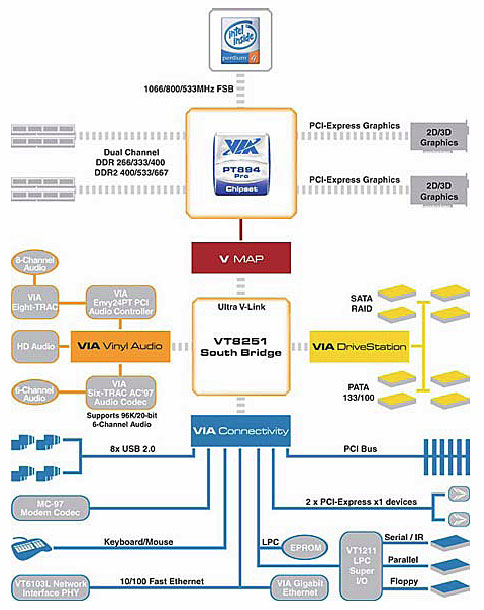VIA PT Series: VIA PCI Express for Intel
by Wesley Fink on January 31, 2005 12:01 PM EST- Posted in
- CPUs
PT894 & PT894 PRO
The 894 chipset family is aimed at the computer enthusiast.


The 894 and 894 Pro differ only in the graphics capability, with the Pro version able to run two PCI Express cards driving up to 4 monitors. This is not the same as the SLI solution provided by the nVidia chipset for the AMD Athlon 64. SLI combines the capabilities of 2 PCIe cards in alternate frame rendering, while the VIA Intel solution merely supports two PCIe video cards running at the same time - one, a full x16 and the other, x4. VIA calls this feature "Video GFX".
The emphasis in Video GFX is multi-monitor support, which can be useful in many different system configurations.
- PCI Express x16 Lane for primary graphics display
- Games
- Advanced Rendering
- PCI Express x4 Connection for secondary displays
- Toolbars
- Monitoring
- Information










25 Comments
View All Comments
ChineseDemocracyGNR - Monday, January 31, 2005 - link
#14,we don't even know if the PT894 Pro will be more expensive than the PT894, or if it's just a name to help motherboard companies promote their DualGFX products. The nVidia nForce4 SLI is $20 more expensive than the Ultra.
As far as "restoring VIA's reputation", they're not going to focus on that when releasing new products. I have worked with their recent chipsets (PT880, PT800, KT880, KT600, K8T800, K8T800Pro) and I don't think there's anything else they could other than continue to bring good chipsets at low prices to make people that had a bad experience with them 5 years ago change their minds.
quanta - Monday, January 31, 2005 - link
If the nForce4 Ultra/SLI mod is of any indication, the PT894[Pro] will be a crippleware scam! Unlike NVIDIA, VIA no longer have any marketing lead to afford ripping off motherboard makers. Support for DDR memory isn't going to restore VIA's reputation, especially with the emerging NVIDIA chipset on Intel platform...ChineseDemocracyGNR - Monday, January 31, 2005 - link
Just for the curious, PCPer has pictures of PT880 Pro and PT894 Pro boards. So what? Well, the PT894 Pro is using the VT8251 southbridge. :)http://www.pcper.com/article.php?aid=114&type=...
These two look very much like Jetway boards from the color scheme. ABIT's PT880Pro is also there.
MS - Monday, January 31, 2005 - link
"Amd socket 939 = socket 754 + 184 pin = 938 pin "That's not exactly how it works, there are a number of power and ground pins that are not tied to the CPU at all. In other words, the calculation comes out somewhat close to reality but that is just coincidence. Otherwise, the Socket940 which needs to use 8 extra data lines and additional clock input would have a much higher pin count than just one over 939.
Wesley Fink - Monday, January 31, 2005 - link
ALL - We apologize for the confusion this morning. The article posted at 6AM when the VIA NDA was 12 Noon EST (9AM PST). As soon as we realized this the article came down and went back up at the correct NDA time.#6 - Corrected
Dranzerk - Monday, January 31, 2005 - link
Wow, this will make for a nice upgrade path for people. If they show up on market fast enough, and ample supply they should do well.Jep4444 - Monday, January 31, 2005 - link
Socket 754 and 939 have a few useless pins. I believe 939 has an extra useless pin.I'm not sure if thats how it works though.
nserra - Monday, January 31, 2005 - link
The power of the DDR dimm is drained by the amd processor, or by board? If its the board how many pins are needed? Thanks in advance.#avijay thanks but you didnt answer my question:
- Amd socket 939 = socket 754 + 184 pin = 938 pin
avijay - Monday, January 31, 2005 - link
#5 skt939 has dual channel memory controller, not single channel like skt754. I think you can add that for the extra pin in the pin count.avijay - Monday, January 31, 2005 - link
As always, a very nice article! Just one thing to point out:(Page 6) table:
VIA PT894 Reference Board Specifications
CPU Interface Socket 939 Athlon 64 ???
shouldn't that be skt 775!
you might like to correct that wesley.